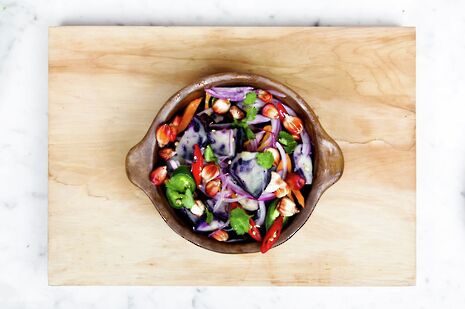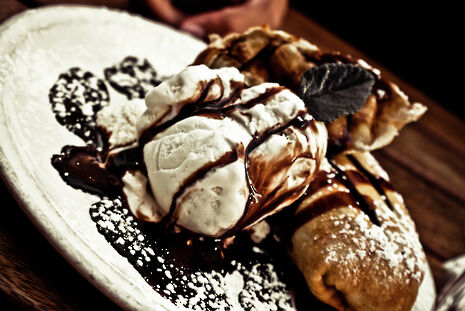Duelling with the double-edged sword: Clean eating and food porn
Coco Whittaker explores our society’s dichotomisation of food into ‘good’ and ‘bad’, and explains how this can lead to unhealthy habits
CN: discussion of anorexia

At 19 years old, I discovered a diet where I could eat all the food I had been coveting – white sliced bread, bags of popcorn, fizzy drinks – and still lose weight because all these foods were zero or low calorie in content.
My 5ft 7 frame ended up weighing seven and a half stone. I was light-headed and dizzy and couldn’t concentrate. I was constantly cold and found it painful to sit down on a normal chair. At my worst, I stopped finding things funny, I stopped laughing and I stopped getting my period.
As a society we took up arms against ‘unhealthy’ eating habits and turned to ‘clean eating’: eating unprocessed ‘whole foods’ in their ‘natural state’ — spiralled courgette, cauliflower couscous, almond milk. Accompanying came a flood of food blogs, many of which feature a centrally-framed colourful veg bowl mounted on a rustic wooden table or balanced on crisp white sheets. Here, ‘healthy’ food is held up for display and approval— it is celebrated as an aesthetic object above all else.
‘Wellness’ and ‘clean eating’ are not so much about a quick-fix weight-loss solution; they claim to be a lifestyle choice that improves mind and body alike. It is now not just about measurements but also about how you measure up as a person: your self-respect, and your responsibility to yourself. If you don’t soak your porridge oats overnight, wake up early to do yoga, and gulp down a large glass of lemon-infused water before your morning coffee to ‘hydrate before you caffeinate’, then you might as well go back to bed… indefinitely. As the writer Ruby Tandoh points out, the danger is not in the ‘clean eating’ but in that it assumes the guise of self-care and tends to have a far more damaging effect – it is, after all, just another form of eating based on restriction.
It is now not just about measurements but also about how you measure up as a person: your self-respect, and your responsibility to yourself.
The success of clean eating relies, somewhat, on the power of its rhetoric. The language we use to describe our relationship with food is often absurdly moralising. While we deem some foods ‘pure’, ‘naked’ and ‘good’, others are condemned as ‘bad’, even ‘evil’. While some people are able to outwit the body, others are slaves to their baser bodily desires. If we succumb to temptation and indulge in those foods, we are overwhelmed by shame and guilt.
Alongside the rise of the clean eating cult, food porn reared its ugly head. Food porn manifests itself as photographs and videos of incredibly rich and high-calorie foods which look fabulously mouth-watering and painfully enticing. These clips, which crop up on our Facebook timelines, are not real recipes – instead, they feed the eyes and stimulate the viewer’s appetite. However, they can also serve as a substitute for food, enabling the viewer to tease out their darkest craving yet resist the urge to eat. You can’t eat the towering cookie-ice-cream-sandwich-chocolate-dipped-marshmallow-Nutella-covered-sprinkled-toffee-drizzled stack, but you sure can look at it and imagine eating it. In these glamour shots, food is fetishised and despised; lusted after but feared.
Food porn, as the name suggests, makes apparent the connection between food and sex – but more than that, between consumerism and virtual consumerism. Where porn is concerned with flesh – flesh as sexy and lusted after but with the tacit understanding that it’s also bad for us – food porn is concerned with meat, as something equally as mouth-watering and equally as bad. Porn and food porn both rely on distance: the consumer’s physical absence. The aim is to stifle taste and feed the eyes alone.
Although food porn looks like the antithesis to restrictive diets – thus being the opposite of clean eating – they’re part of the same parasite. By casting food as either clean or dirty, as virtue or vice, we are unable to recognise it for what it really is: simple sustenance and a source of enjoyment.
It’s on platforms like Instagram where we see the two in direct contrast. Although in content they drastically differ, they’re framed in exactly the same way – literally in the trademark Instagram square. Instagram therefore encourages the view that food has to be either tightly controlled or completely uncontrollable. The clean eating vs. food porn dichotomy leaves no room for healthy, fun food; it is either unhealthy and fun or healthy and mirthless.

All of this is bound up in gender. Our attitude towards female appetite is a double-edged sword. It’s lame and cliché for women to eat salads; we love women who eat burgers and chips. But if you’re not very thin, then eating anything that’s not a salad is embarrassing and disgusting.
There are small ways in which women take the submissive role in relation to food: I used to work as a waitress in my local pub and I was surprised by how common it was for the husbands of a party to order pudding and for the wives to abstain or, if they opted in for a dessert, to make excuses. A typical instance was when I waited on a table of four, two heterosexual couples. The men ordered first— one sticky toffee pudding and one chocolate fudge cake. Then it was the women’s turn – ‘oh, well, why not, just this once’ – one banoffee pie – ‘as a treat!’ – and one crème brûlée – ‘to share!’. It is absurd that these women felt the need to justify themselves to me and, more absurdly, to their partners. A woman can only indulge if she acknowledges her transgression.
Christmas can be a difficult time for someone with, or recovering from, an eating disorder. Fortunately, dealing with Christmas is made easier by the positive culture that surrounds it – we are reminded of how lovely it is to enjoy eating and drinking with friends and family. It is a time for Christmas pudding, mulled wine and mince pies. It is the first couple of months of the New Year that I (and I’m sure others in a similar position) find more difficult. With January 1st comes the beginning of ‘the diet season’— the start of the race to lose weight and make up for over-indulging during the Christmas period. Now we are confronted by magazine headlines which urge us to “Wage War on Christmas Excess”, alongside adverts for gym subscriptions and top tips for hard and fast weight-loss solutions. I don’t have much to say about this type of commercialised body warfare, except that it’s irresponsible and not worth mine or anyone else’s time.
‘Health’ is defined in the dictionary simply as ‘the state of being free from illness and injury’, but the rise of clean eating warps our notion of what is healthy. I have been trying to learn to listen to my body for the past year – for too long it has been forced to be submissive, quiet, fragile. I’ve started having my period again. I feel reconnected, not only to my body but to the greater, messier mass that is the experience of being human and being a woman. I am no longer contained within straight lines: here I am, becoming complete
 News / Clare Hall spent over £500k opposing busway 24 December 2025
News / Clare Hall spent over £500k opposing busway 24 December 2025 Comment / The ‘class’ of Cambridge24 December 2025
Comment / The ‘class’ of Cambridge24 December 2025 News / Caius mourns its tree-mendous loss23 December 2025
News / Caius mourns its tree-mendous loss23 December 2025 Comment / League tables do more harm than good26 December 2025
Comment / League tables do more harm than good26 December 2025 News / Eight Cambridge researchers awarded €17m in ERC research grants27 December 2025
News / Eight Cambridge researchers awarded €17m in ERC research grants27 December 2025








